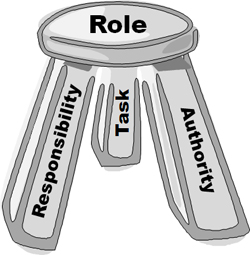Role
Role is the bundling of tasks, authority and responsibility for the description of job positions, activities and people. This can be used to create generalized profiles that can be used for similar tasks. That lowers the efforts for the documentation and makes the roles comparable across borders. Employees are easier to be identified and applied according to their roles. Double work and unclear responsibilities can be revealed.
Role model consists of three aspects: task, authority and responsibility.

Task
Tasks are the activities of a role. These may be operational or leadership tasks that are used in core and support processes. Examples are storing parts, sending an invoice, making staff appraisal.
Authority
Authority describes the rights of the role. On the one hand, the execution of tasks must be authorized - to do something, to make an application, to decide something. On the other hand, the leadership authority needs the power to give directions, to lead employees, to decide guidelines and to control the field. The format of the authorization may be more or less formal.
Responsibility
Responsibility describes the liability to account for actions, results and consequences that come out of the task. Individual responsibility is determined by one’s own action or the doing of the directly assigned employees. Joint responsibility is a consequence of the position and the associated power. It arises, if decisions of other departments are shared or, at least could be affected.
It is good practice to define roles in such a way that task, authority and responsibility are in one hand. It will be difficult to take responsibility, if a task is not equipped with the required authority. Project leader cannot take responsibility for its success, if they do not have the control over the budget.
